Amorgos: Top 9 tips by an (almost) local
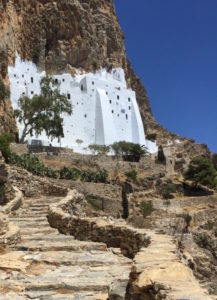
If you asked me which my favorite Greek island is, I would struggle to come up with an answer. Yet, Amorgos would be among the first to spring to my mind. The easternmost of the Cyclades islands may not be as popular as its famous neighbor Santorini, but, cliché as it may sound, it is one of the most beautiful and charming Greek islands. In the last few years, however, it has been popular with the French, since it featured in Luc Besson’s film ‘Le Grand Bleu’ (‘The Big Blue’). It is a medium-sized island (for the Greek standards) with a population of 1,973; it is 18 miles long and 1.5 miles wide at its narrowest and 5 miles wide at its broadest.
Tip 1: Hike your way to Hora (and beyond)
As well as its role in the French cult-classic, Amorgos is also renowned for its hiking trails, which not only connect the island’s villages and settlements, but also provide access to ecclesiastical and natural landmarks, and several archaeological sites (Minoa, Arkesini and Vigla) (read tip 8).
One of these trails, Fotodotis, connects Katapola (the main port) (read tip 5) with Hora (the capital and one of the main settlements of the island) (read tip 2). This ascending path is rather short and easy, so if your accommodation is at Katapola (like mine was), why not walk to Hora? Start your ascend not long before sunset, so you can watch the sun diving into the deep blue waters of the Aegean.
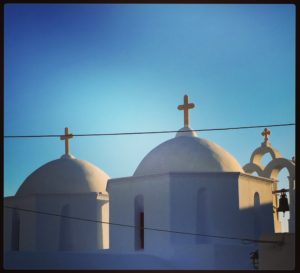
Tip 2: Fall in love with Hora
Hora is a charming inland village built on top of the mount Profitis Ilias. Stroll through its narrow streets where blushing bougainvillaeas climb the walls of white-washed houses and blue-domed churches and chapels; their doors and window shutters have been painted blue, red or green, matching the chairs and tables scattered around the cobblestone alleys. Hora is a great place to have coffee and dessert (at Kallisto), try the local cuisine (at Tranzistoraki), or enjoy a few cocktails (at Botilia) (read tip 9).
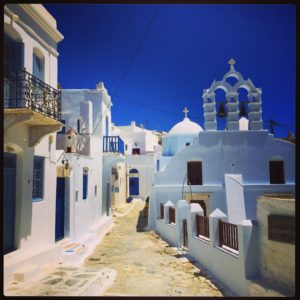
Tip 3: Visit Panagia Hozoviotissa and Agia Anna
Walk past the windmills at the edge of Hora towards the landmark of Amorgos, the Greek-Orthodox monastery of Panagia Hozoviotissa. Built by Byzantine emperor Alexius Comnenus I in the 11th century, this whitewashed monastery is wedged into a cliff face 300 metres above the sea. Climb the nearly 300 steps, walk through the low marble doorway and take the staircase that leads to the chapel where treasures and icons are kept. You will be rewarded with a vertiginous yet panoramic view of the Mediterranean, complimentary rose-flavoured loukoumi (Greek Turkish delight) and psimeni raki (raki with honey and spices) offered by the monks. From there, descend towards the pebble beach of Agia Anna. Here the waves splash against a rock, which a chapel of the same name is built on. It’s then time to dive into the deep blue Aegean.
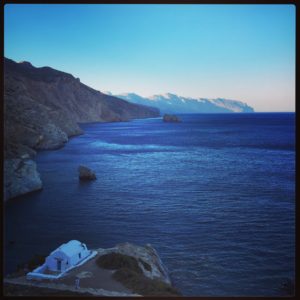
Tip 4: Dive into the ‘Big Blue’
Luc Besson’s film, released in 1988, tells the story of the friendship and rivalry between two divers, Jacques and Enzo, a story that begins in Amorgos in the 1960s. Why not follow their example and go diving? There are two diving centres: Amorgos Diving Center in Aegiali, and We Shall Sea in Katapola.
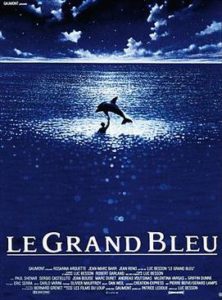
Tip 5: Katapola is more than a port
Katapola is the main port of the island and home to one of the two diving centres (read tip 4). Here you can also find several seaside taverns (Capetan Dimos, Almyriki and Vitsentzos) as well as Moonbar, where you can enjoy a refreshing cinnamon-based drink (read tip 9).
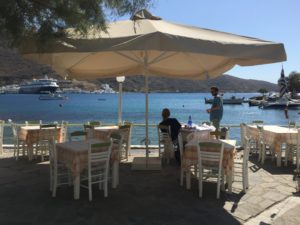
From Katapola, you can take the boat taxi, or walk to Maltezi, a nearby secluded beach.
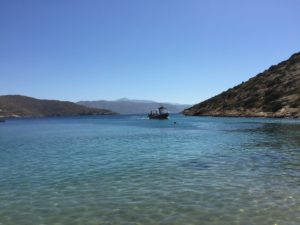
Tip 6: Go to Aegiali and explore the north-western part of Amorgos
Drive north to Aegiali. A wonderful drive along a winding road will bring you to this small village, where you can embark on one of the most scenery and beautiful hiking trails on the island. Walk past the small church of Agia Barbara towards Agios Theologos. Dedicated to John the Evangelist and built on the site of an ancient temple, this beautiful Byzantine monastery dates back to the 7th century. Continue on the precariously narrow path towards the beautiful chapel of Stavros, situated above an old bauxite mine. The trail ends up at the summit of mount Krikelos, the highest point of Amorgos. The view is compensation: from here you can see the whole island and the endless Aegean Sea.
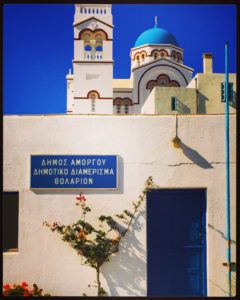
On your way back, follow the stone-paved path towards Panagia Epanohoriani. Before you, the old church stands tall; behind you lies the islet of Nikouria. Stop at the charming old-fashioned mountain village Tholaria, to savour a Greek coffee at Kali Kardia, an old-style café-ouzo-mezedopolio (place that serves coffee, ouzo and mezedes) (read tip 9).
Continue to Aegiali beach. There you will find DISCOtheQUE (simply Q for the locals), an all-day beach bar where teenagers sip iced coffees, which will later turn to beers and cocktails, as the day turns to night.
Tip 7: Go to Kalotaritissa and discover the south-eastern part of Amorgos
Drive south to Kalotaritissa. On your way there, you will catch glimpse of the rusty shipwreck Inland now known as Olympia, which has been lying at the small bay of Livero for the last 40 years. Continue towards Kalotaritissa; a rainbow of fishing boats anchored in the small bay will soon appear. A little café on the semi-organised sandy beach serves tyropita (cheese pie) and mpougatsa (filo pastry with custard). Hop on the boat taxi, which will take you to the uninhabited islet of Gramvousa. Walk past the small chapel, and you will find yourself in a secluded beach.
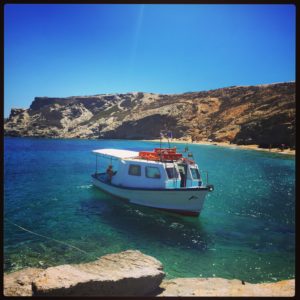
Tip 8: Get to know the history of the island
In a country with very rich history, which continues to be part of its people’s psyche, archaeological sites and museums are ubiquitous. Amorgos is no exception to this and is home to three archaeological sites (Vigla, Minoa and Arkesini), as well as three museums (one archaeological and two ecclesiastical).
Ancient Vigla, located close to the village of Tholaria, is home to the acropolis of ancient Aegialis; the biggest sculpture of the Cycladic Age was also found in this area. Close to Katapola is ancient Minoa, named after the Cretan king Minos, who had his summer residence there; in the prehistoric times it was one of the most important centers of human life and activity on the island. The walking path Itonia connects Minoa with the archaeological site of ancient Arkesini (not to be confused with the modern village of Arkesini).
Located in Hora and housed in the traditional mansion known as Sala tou Gavra, the archaeological museum contains interesting pieces excavated on the island; these include 4000-year-old remnants of the Minoan civilisation, marbles of Cycladic culture and architectural finds from the Hellenistic, Roman and Early Christian periods.
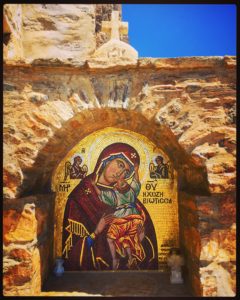
There are also two ecclesiastical museums on the island; one below the Church Agion Anargiron in Tholaria, and one at the Monastery of Hozoviotissa, containing manuscripts, icons, crosses and other examples of Byzantine ecclesiastical art dating as back as the 10th century AD.
Tip 9: My favorite places to eat and drink
I’ve already mentioned a few of my favorite places to eat and drink; and here’s a summary:
In Hora, you will find the little café-patisserie Kallisto, one of my favorite places on the island. The reason? Their fragrant and moist portokalopita (orange pie) indulgently served with vanilla ice-cream.

There are also several taverns in Hora; Tranzistoraki stands out for its food as well as its atmosphere. Try their pancetta with fig marmalade.
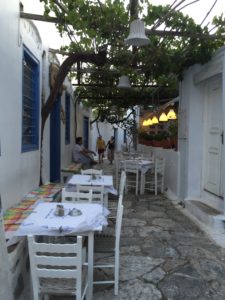
In Katapola, have a meal at Capetan Dimos on the side where the ferries arrive, or at Almyriki and Vitsentzos on the opposite side. Try some seafood dishes (it couldn’t get any fresher) or the local specialty patatato (goat with potatoes) along with some Amorgean white wine.
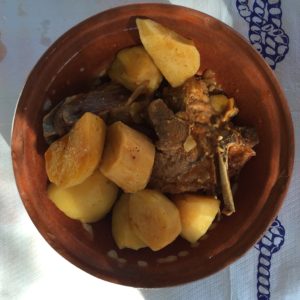
In Tholaria, have a Greek coffee at Kali Kardia, an old-style café-ouzo-mezedopolio (place that serves coffee, ouzo and mezedes). Also, try a few dishes, including their meatballs.
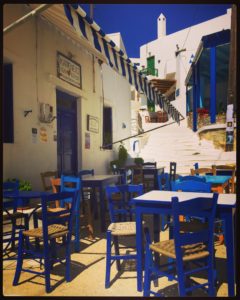
In Kalotaritissa, you will find a little beach café that serves tyropita (cheese pie) and mpougatsa (filo pastry with custard).
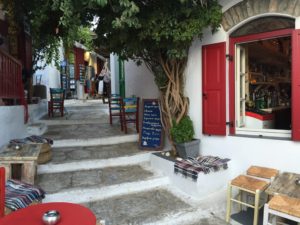
In the evening, enjoy a few drinks at cocktail-bar Botilia in Hora, at Moonbar in Katapola, or at DISCOtheQUE, in Aegiali.
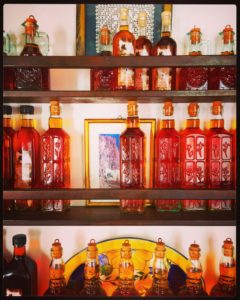
Finally, try psimeni raki (raki with honey and spices), which you can also purchase to take home with you.
How to get there
Amorgos has no airport but has two ports (Katapola and Aegiali), both located on the west coast of the island. There are daily ferries from Piraeus (the port of Athens); Hellenic Seaways is the fastest at six hours an a half (approx. 70 euros). There are also ferries from other Cycladic islands. From Santorini, the journey takes an hour on Mondays, Wednesdays, Thursdays and Saturdays (SeaJets, approx. 50 euros), but considerably longer on Tuesdays, Fridays and Sundays. Check out the ferries timetable here.
If you’re planning to visit several islands, the Eurail Greek Islands Pass is worth considering.
Once on the island, I would strongly recommend you rent a car.
When and how long to visit
For me, the best time to visit Amorgos (and the Greek islands in general) is the summer; this is when the ferries are at their most frequent, the weather at its warmest and the atmosphere at its best. If you’re planning an island-hopping holiday, July and August are the best months. I would recommend staying there for at least three days.
Accommodation
Aegialis Hotel & Spa is the only five-star hotel on the island; it is located near the village and port of Aegiali on the northwest coast. If you stay only for a few days, however, it might be better to stay in Katapola or in Hora.
Further reading
To better prepare for my trip, I used the Lonely Planet Greek Islands Travel Guide
For more tips about Amorgos and other Greek islands, read the Guardian readers’ travel tips.
If you’d like a book to read whilst on holiday, check out my post ‘Crime & Fjords: 9 Scandinavian writers you should read’.
Amorgos is in close proximity to a large number of charming islands. Read my 2-week itinerary around the Cyclades here.
To follow my travels around the world, simply subscribe to the Traveling Psychiatrist (just click on the menu on the left hand side).
Have a great journey!
Alex
(the Traveling Psychiatrist)
One Comment
Pingback: